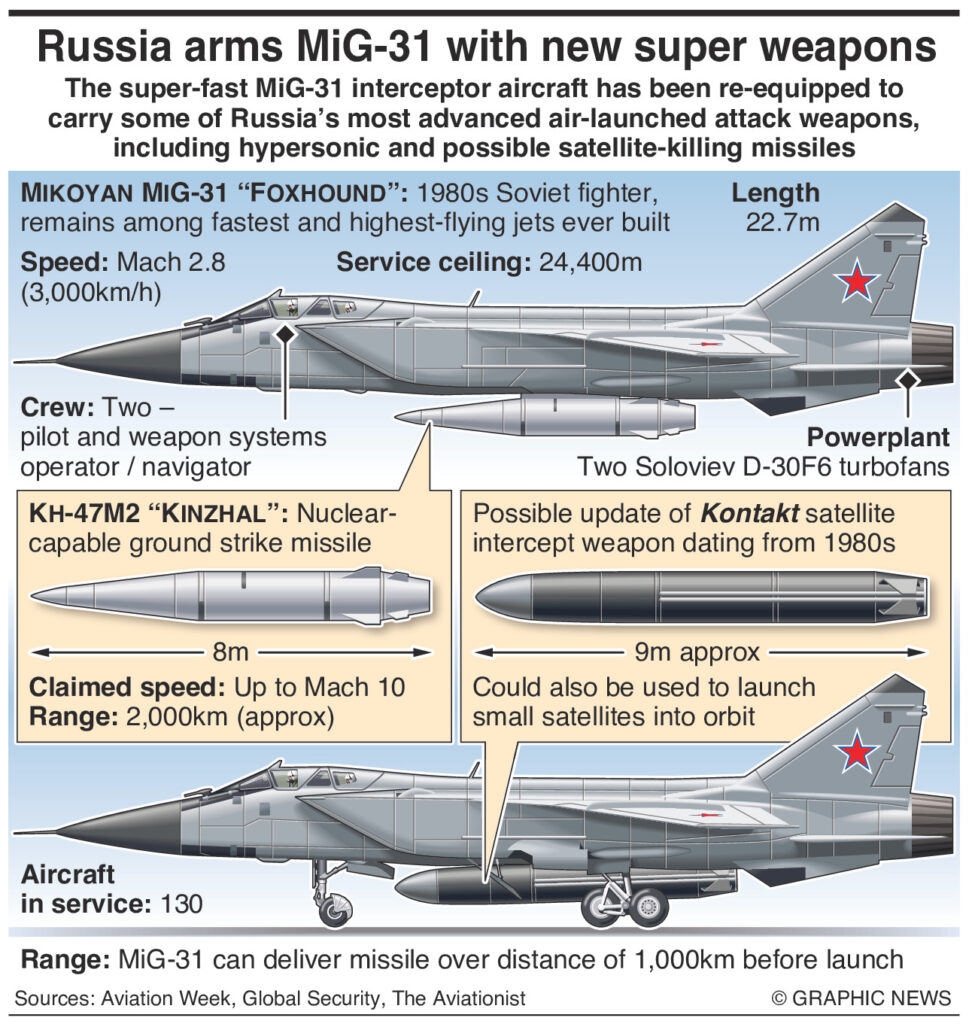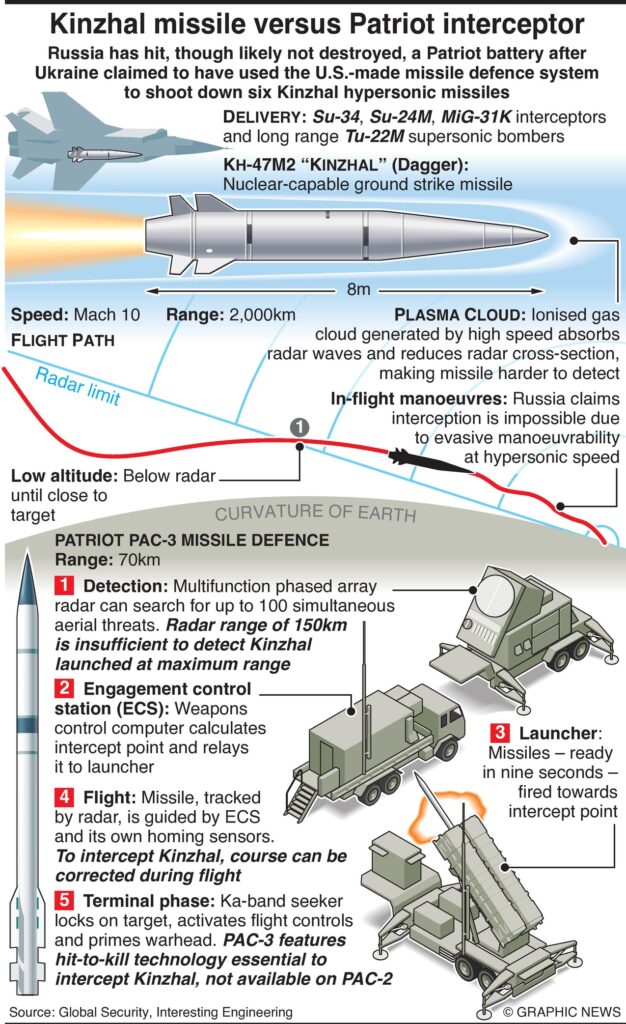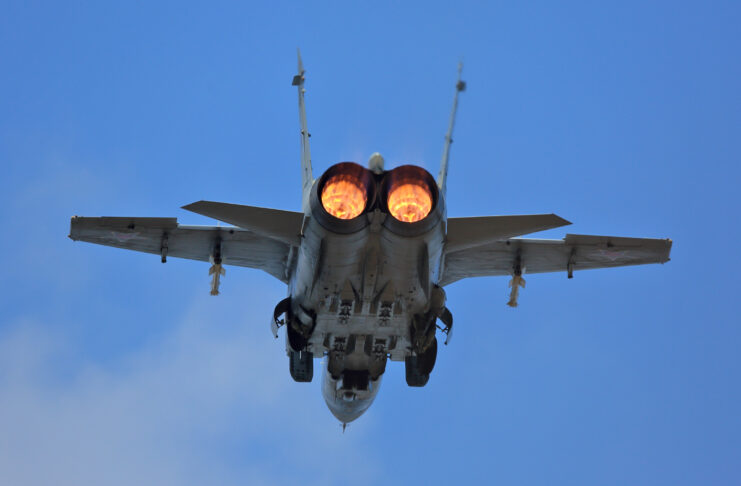ANALYSIS – Idle threat? In a bid to be relevant to the conflict in the Middle East and try to counter the growing U.S. armada in the Eastern Mediterranean, Vladimir Putin is getting frisky.
He also appears to be feeling especially tough while visiting his powerful ally (aka boss), Chinese communist leader Xi Jinping, in Beijing.
Putin said he and Xi discussed the wars in Ukraine and the Middle East during their talks, adding that Russia and China faced “common threats” that strengthen their ties.
The fact that the U.S. just crossed one of Putin's red lines by secretly sending long-range ATACMS (Army Tactical Missile Systems) to Ukraine – which it promptly used to destroy numerous Russian aircraft in Russian-occupied areas of eastern Ukraine – likely also factored into Putin's tough talk. (RELATED: What If Putin Used A Nuke In Ukraine?)
On Wednesday, he told reporters he had ordered MiG-31 aircraft armed with Kinzhal missiles (Russian for Dagger) that “have a range of more than 1,000 kilometers [620 miles], a speed of Mach 9” to conduct permanent missions over international waters in the Black Sea.
“This is not a threat, but we will exercise visual control – control with weapons – over what is happening in the Mediterranean Sea,” Putin said.
Sounds menacing, but…
One significant challenge Russia would face if it chose to fire missiles from the Black Sea into the Eastern Mediterranean is it would have to fly them over Turkey, a large, well-armed (if troublesome) NATO member. There are other challenges, too.
Russia reportedly first used the new missiles in Ukraine in the spring of 2022 when it hit a fuel depot near the Black Sea port of Mykolaiv and an ammunition depot in the Carpathian Mountains in western Ukraine. (RELATED: Video: Russia Conducting Potentially Lethal Strikes 200 Meters From NATO Country)

Kinzhals are designed to evade missile defense, partly through their high speed, low trajectory, and maneuverability and due to the formation of a plasma cloud in front of the missile, which interferes with radar waves.
A Kinzhal launched from a MiG-31k traveling at Mach 2.7 would then use rocket propulsion to accelerate to speeds more than Mach 9.
Weapon experts believe that the Kinzhal is simply a modified version of the Iskander missile, a ground-based weapon system that has been a mainstay of the Russian arsenal for over a decade, and neither a true hypersonic cruise missile nor maneuverable glide vehicle.
They are also doubting whether the Russian ‘superweapon' can attain, or sustain, Mach 9 flight.
After their first use in Ukraine, they weren't deployed again for eight months, giving the Ukrainians plenty of time to study and analyze it. Kyiv then developed capabilities to effectively counter this once unstoppable weapon.

By the time Moscow launched a barrage of Kinzhals in May 2023 the Ukrainians claimed to have shot down five of the six missiles with recently U.S.-supplied Patriot anti-missile systems.
U.S. government sources later confirmed those reports.
Meanwhile, in the real world, U.S. forces near Israel just shot down some missiles and drones. (RELATED: US Navy Intercepts Missiles Fired From Yemen: Report)
In what was potentially a U.S. Navy first, on Thursday ABC News reported that: “The USS Carney, a U.S. Navy guided-missile destroyer in the northern Red Sea, on Thursday shot down multiple missiles and drones launched by Iranian-backed Houthis in Yemen that the Pentagon said were potentially headed toward targets in Israel.”
The Carney is part of the USS Gerald R. Ford carrier strike group deployed in the eastern Mediterranean. The Houthi missiles and drones were intercepted by the ship's SM2 air defense missiles.
As ABC News noted, “The USS Carney had just transited into the Red Sea through the Suez Canal on Wednesday, which is why the destroyer was still located in the northern stretch of that body of water that borders Egypt's Sinai Peninsula, Sudan, Saudi Arabia, and Yemen.”
The Pentagon said that the Carney had brought down eight drones launched by the Houthis and that they did not appear to be threatening the U.S. warship. This would be a first.
Earlier, U.S. bases in Iraq and Syria were also targeted by drones, some of which were destroyed by U.S. forces. (RELATED: Drones Injure US Troops In Syria Attacks)
According to Military.com, Pentagon spokesman Brig. Gen. Pat Ryder said: These small-scale attacks are clearly concerning and dangerous,” adding: “We're going to do everything we can to ensure deterrence in the region, so that this does not become a broader regional conflict.”
The opinions expressed in this article are those of the author and do not necessarily reflect the positions of American Liberty News.
READ NEXT: ‘Surprise' Witness Could Damage Trump's Defense


